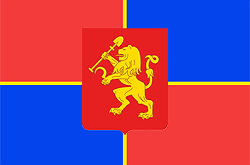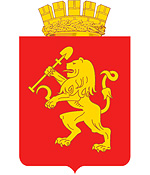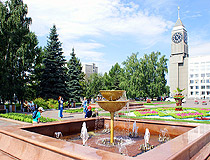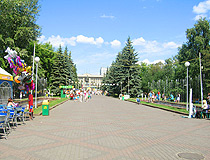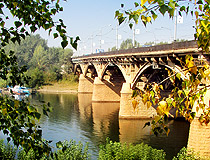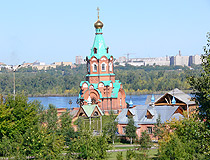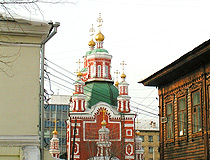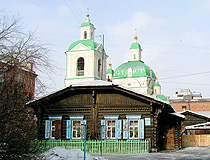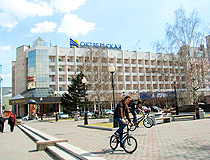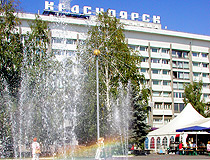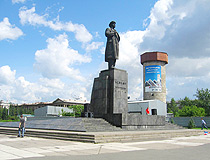History of Krasnoyarsk
Foundation of Krasnoyarsk
Krasnoyarsk is one of the oldest cities in Siberia. People began to settle in the territory of Krasnoyarsk from the Upper Paleolithic era (about 28-32 thousand years ago). Before the arrival of the Russians, it was part of the Yezher Principality of the Yenisei Kyrgyz.
This area became known to the Russians in 1608, when the Cossacks went up the Yenisei River with the intention of finding new lands and annexing them to the possessions of the Moscow Tsar. Local tribes refused to pay yasak (tribute) to the Russians and bothered them with raids. Therefore, the Cossacks decided to turn to the Yenisei voivode with a request for help and protection.
The Yenisei voivode Yakov Khripunov sent a nobleman Andrei Dubensky to inspect the land occupied by the Cossacks and find a place to build a fortified settlement. Dubensky found it at the confluence of the Kacha River into the Yenisei, made a plan, and with it went to Moscow. The presented plan was approved and he was allowed to proceed with the construction of the settlement.
At the end of 1627, after returning from Moscow, Dubensky with three hundred Cossacks left Yeniseisk to found a new fortified settlement. On August 19, 1628, the construction of a small fort called “Krasnyy Yar” (literally meaning “red steep bank”) was completed below Krasnoyarsk, opposite Tatyshev Island. It was named after the red color of marl of the left high bank of the Kacha River. This day is considered the day of foundation of Krasnoyarsk.
More Historical Facts…
Initially, the most important function of the fort was the defense of the main Russian settlements of Siberia from the south. The Yenisei Kyrgyz and tribes subordinate to them repeatedly attacked the fort of Krasnyy Yar and the villages located next to it. The most devastating raids were in 1630, 1634, 1635, 1636, 1640, 1665, 1667, and 1679.
In 1673, Krasnoyarsk under the name “Krasnagair” was first mentioned in Western European literature - in “The Description of Siberia” by German author Albrecht Dobbin. In 1690, the settlement was granted town status.
Krasnoyarsk in the 18th-19th centuries
In 1708, the population of Krasnoyarsk was 849 people. In 1713, 1,295 men and 1,217 women lived in it. After the defeat of the Yenisei Kyrgyz, the departure of their princes to the foothills of the Tien Shan, the construction of the Abakan and Sayan forts, and the signing of the Kyakhta peace with Manchuria in 1728, Krasnoyarsk lost its strategic importance as a military outpost.
In 1733-1734, Vitus Jonassen Bering, a Danish cartographer and explorer in Russian service, lived in Krasnoyarsk procuring provisions and equipment for his expedition. The gradual growth of Krasnoyarsk began, when the Siberian Route reached it in 1735 (the federal highway R255 “Siberia”). This road connected Krasnoyarsk with Achinsk, Kansk, and other parts of the Russian Empire.
In 1772, the population of Krasnoyarsk was only about 2 thousand people, it remained a small district town. In 1734-1743, the German natural scientist and traveler Johann Georg Gmelin lived and worked in Krasnoyarsk. In 1756, an ironworks was founded near the town.
In 1771-1773, the famous Prussian zoologist and botanist Peter Simon Pallas visited Krasnoyarsk three times. Here he discovered a 680-kilogram meteorite fragment named “Krasnojarsk”. It was the first meteorite discovered in Russia and the first pallasite meteorite ever found.
After the fire of 1773, there were only thirty houses left in Krasnoyarsk. The geodesy sergeant Pyotr Moiseev was sent to Krasnoyarsk from Tobolsk to draw up a new linear layout for the town on the model of St. Petersburg. This became the beginning of today’s Krasnoyarsk.
The life of the town changed when the Yenisei Governorate was created in 1822. Krasnoyarsk was chosen as its center. It was not the largest town in the region, but it occupied the most favorable economic and geographical position. The town was one of the places of political exile. Eight Decembrists were exiled to Krasnoyarsk after the suppression of the 1825 uprising.
In 1834, a town garden (present Central Park) was laid out in Krasnoyarsk. In 1846, a public library was opened. In 1856, the population of Krasnoyarsk was about 6,400 people. In 1863, shipping began along the Yenisei. At the same time, a telegraph station began operating in the town. In 1889, the town public museum was opened in Krasnoyarsk, as well as the first medical assistant school in Siberia.
In 1894, the first technical railway school in Siberia was opened in Krasnoyarsk. Further growth of the town was connected with the discovery of gold in the region and the advent of the railway in 1895. The supply of rails for the construction of the Trans-Siberian Railway was carried out by the Northern Sea Route. In 1897, the population of Krasnoyarsk was about 26,700 people.
Krasnoyarsk in the 20th century and beyond
In 1908, the first stationary movie theater was opened in Krasnoyarsk. In 1912, the first power station was commissioned. In 1913, the first city water supply system was built. In September 1913, the Norwegian explorer Fridtjof Nansen stayed in Krasnoyarsk making a trip to Eastern Siberia and the Far East. His goal was to establish permanent trade relations with Central Siberia by sea through the Kara Sea and the Yenisei River.
During the First World War, one of the largest prisoners of war camps in the Russian Empire was organized in Krasnoyarsk. By the end of 1915, there were about 13 thousand prisoners of war in it. In 1920, Maria Bochkareva, the creator of the first women’s battalion in the history of the Russian army, was sentenced to death in Krasnoyarsk because of her active involvement in the fight against the Bolsheviks. In 1923, the population of Krasnoyarsk was 59,258 people.
In 1934, Krasnoyarsk became the administrative center of Krasnoyarsk Krai. In 1939, there were 189,977 residents in this city. By the beginning of 1941, about 39,000 people worked at all industrial enterprises of Krasnoyarsk.
During the Second World War, a number of factories from European Russia were evacuated to the city. The Alsib (Alaska-Siberia) air route passed through Krasnoyarsk. It was used as a stop by military aircraft sent from the USA and the aircraft factories of Irkutsk, Ulan-Ude, Komsomolsk-on-Amur. During the war years, the industrial power of Krasnoyarsk increased by 7 times. It became the main industrial center of Eastern Siberia.
The development of the hydropower resources of the Angara and the Yenisei, which began in the postwar years, became a new page in the history of Krasnoyarsk. During this period of industrial growth, not only a powerful electric power industry was created, but also large enterprises of the ferrous and non-ferrous metallurgy, pulp and paper, medical and chemical industries were built.
Krasnoyarsk also became a major center of academic science, higher and secondary specialized education. In 1989, the population of Krasnoyarsk was about 912,000 people. After the collapse of the USSR, the city experienced depopulation, its population decreased by about 10%. However, at the end of the 20th century, the population of the city again began to constantly grow.
In 1995, the construction of the Krasnoyarsk metro was started. Several times the construction was stopped due to lack of funds. It is planned that the metro will be open in the mid-2020s.
In 2006, the first of the Russian federal universities, the Siberian Federal University, was established in this city. In 2012, Krasnoyarsk became the 14th city in Russia with a population of more than 1 million people. In 2019, the XXIX World Winter Universiade 2019 was held in the city.
Streets of Krasnoyarsk
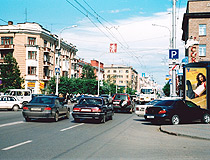
Street traffic in Krasnoyarsk
Author: Oscar Ballesteros
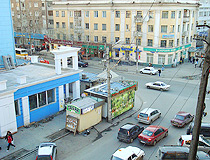
On the street in Krasnoyarsk
Author: Andrey Pivovarov
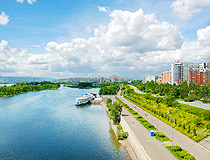
Embankment along the Yenisei River in Krasnoyarsk
Author: Dmitry Antipov
Krasnoyarsk - Features
Krasnoyarsk, located in the forest-steppe zone and in mountainous areas on both banks of the Yenisei River in central Russia, is unofficially called the capital of Siberia. Founded in 1628, it is the largest of the old cities of Siberia. Krasnoyarsk is the easternmost city with a population of more than 1 million people in Russia.
The Yenisei divides Siberia into Western and Eastern, and the city itself is roughly divided by it in half. Krasnoyarsk is one of the most compact million-plus cities in Russia. From west to east, the length of the city is about 41 kilometers, from north to south - almost 37 kilometers.
The lion depicted on the coat of arms of Krasnoyarsk holds a shovel and sickle in its paws - symbols of gold mining and agriculture. Today, about 20% of all gold in Russia is mined in Krasnoyarsk Krai.
The climate of Krasnoyarsk is continental, moderated by large masses of water (Krasnoyarsk reservoir), the ice-free Yenisei, and the surrounding mountains. Winter is not snowy, with frequent thaws. The average temperature in January is minus 15.5 degrees Celsius, in July - plus 18.7 degrees Celsius.
Krasnoyarsk is a developed center of industry in Russia. On the territory of the city there are more than 17,000 enterprises, organizations, institutions. The leading industries are space industry, non-ferrous metallurgy, mechanical engineering, woodworking, transportation, chemical, food, retail and wholesale, services.
This city is a major transit hub of Eastern Siberia located at the intersection of the Trans-Siberian Railway and historical trade routes along the Yenisei River. The federal highway “Siberia” R255 Novosibirsk - Krasnoyarsk - Irkutsk, which is part of the Moscow - Vladivostok route, passes through the city.
The international airport of Krasnoyarsk offers regular flights to Vladivostok, Irkutsk, Kazan, Krasnodar, Moscow, Novosibirsk, Norilsk, St. Petersburg, Sochi, Surgut, Tomsk, Khabarovsk, Chelyabinsk, Chita, Yakutsk, and a number of other cities.
Krasnoyarsk is also a large scientific, educational, and sports center of Russia. At the Siberian Federal University alone, over 40,000 students are studying. In total, there are more than 150,000 students in the city.
The design of the Russian 10 ruble banknote is dedicated to Krasnoyarsk. On it you can see the Paraskeva Pyatnitsa Chapel, the Communal Bridge, and the Krasnoyarsk Hydroelectric Power Station. Today, these banknotes are almost completely withdrawn from circulation.
Main Attractions of Krasnoyarsk
Stolby Nature Reserve - a natural area located on the northwestern spurs of the Eastern Sayan Mountains limited by the right tributaries of the Yenisei River and starting within the city limits of Krasnoyarsk. Here you can see unique rock formations, which are called “stolby” (“pillars”). The flora of the reserve is the dense Siberian taiga. There is a large tourist area with hiking and sports routes.
The Paraskeva Pyatnitsa Chapel (1852-1855) - an Orthodox church standing on Karaulnaya Mount, one of the symbols of Krasnoyarsk. The first chapel at this place was built of wood and also served as a guard tower. The stone structure was erected at the expense of the gold miner Pyotr Kuznetsov. Stepana Razina Street, 51.
The Flora and Fauna Park “Royev Ruchey” - one of the largest Russian zoos covering an area of 31 hectares and located on the southwestern outskirts of Krasnoyarsk. Its collection is second only to the Moscow Zoo in diversity. Here you can see the largest collection of African mammals in Siberia. There is also a separate huge aquaterrarium, the only penguinarium east of the Urals, and aviaries with polar bears.
Tatyshev Island - the largest island on the Yenisei River within Krasnoyarsk connected to the city by two bridges. Today, it is a recreation area where you can walk, run, ride a bicycle, roller skates, etc. There is a beach, a picnic area, and an arboretum.
Krasnoyarsk Museum of Local Lore - one of the oldest museums in Siberia and the Far East, one of the largest museums in Russia. The museum building was constructed in the Art Nouveau style and is vaguely reminiscent of an Egyptian temple.
The exposition reflects the history of this huge region from ancient times to the present. Here you can see archaeological, paleontological, art, ethnographic, natural science collections of world significance. Dubrovinskogo Street, 84.
The Vasily Surikov Art Museum - one of the most significant collections of fine art east of the Urals. In total, there are more than 15 thousand works of art. The building of the museum is an object of cultural heritage of the peoples of Russia. The famous Russian artist Vasily Surikov was born in Krasnoyarsk. Parizhskoy Kommuny Street, 20.
The Vasily Surikov Museum-Estate. This museum occupies the house where Vasily Surikov lived. It is a wooden manor of the 1830s built of larch - a typical example of urban construction of the 19th century. The collection has more than 90 works of Surikov himself, as well as interior items and belongings of the artist’s family. Lenina Street, 98.
Literary Museum named after V.P. Astafyev. The museum collection is housed in a picturesque 19th-century mansion built of wood in the Art Nouveau style with Gothic motifs. Today, this building is an architectural monument of federal significance, one of the most beautiful buildings in Krasnoyarsk. Lenina Street, 66.
Steamboat-Museum “Saint Nicholas” - a museum-ship located on the Yenisei embankment. This passenger and cargo river boat was produced at a shipyard in Tyumen in 1886. In the 1950s, the ship was decommissioned. The museum exposition was opened after the overhaul of the ship in the 1970s. Mira Square, 1a.
Holy Intercession Cathedral (1785-1795) - an architectural monument of the Yenisei school of Siberian Baroque, the oldest surviving stone building in Krasnoyarsk. Surikova Street, 26.
Annunciation Church (1804-1812) - a grandiose church built at the junction of two eras and architectural styles - Baroque and Classicism. Its design was developed not by professional architects, but by Tobolsk craftsmen, who made iconostases. Lenina Street, 15.
The Catholic Church of the Transfiguration of the Lord (1909-1911) - a red brick building with elements of the Gothic style. In 1982, the organ hall of the local philharmonic was opened in the building. In 1993, Catholic services were resumed. Dekabristov Street, 20.


